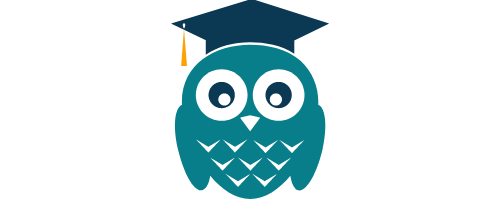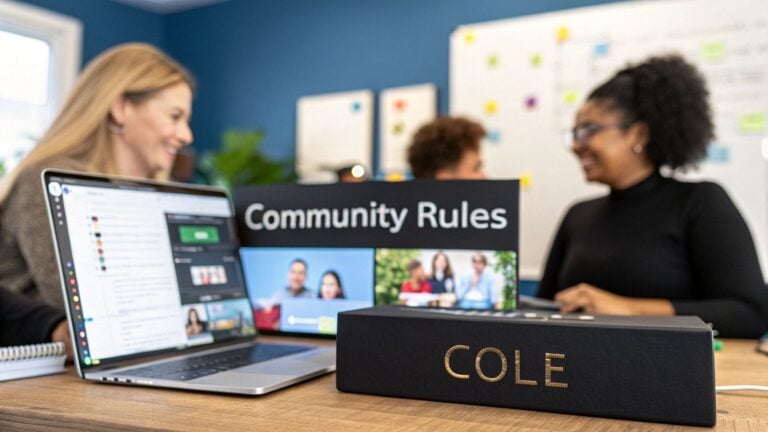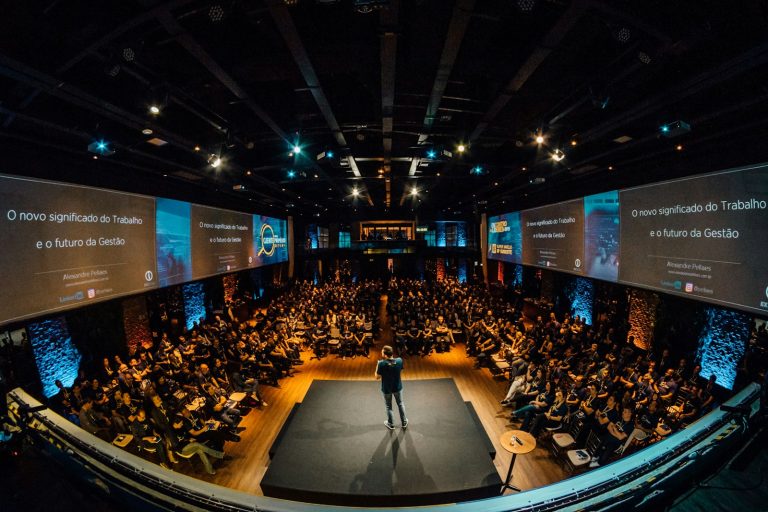Boost Engagement with Cohort Based Courses
A cohort-based course is what happens when online learning stops feeling like a solo trip to the library. It starts feeling like a guided expedition with a team you actually want to hang out with.
You’re not just handed a map and told to find your way. You move through the material with a group of fellow students, all on the same schedule, led by an expert guide.
What Exactly Are Cohort-Based Courses?

If you’ve ever signed up for a typical online course, you probably know the feeling. You get a login, a huge library of pre-recorded videos, and a hopeful “good luck!” It can be a pretty lonely journey.
Honestly, that’s why so many of us never finish them. Some studies have shown that self-paced online courses can have dropout rates as high as 90%. The content itself isn’t necessarily bad, but the learning model often works against human nature.
Cohort-based courses completely flip this model on its head. Instead of learning in isolation, you’re part of a team.
You and your classmates start on the same day, show up for live sessions together, and work toward shared goals on a clear timeline. It’s an active, dynamic approach that builds a powerful sense of community and accountability right from day one.
The Core Components of This Model
So, what makes a cohort-based course feel so different in practice? It usually boils down to a few key ingredients that create a much more engaging, human experience.
- A Shared Timeline: Everyone moves through the material over a set period, like 4 or 8 weeks. This creates a natural pace and a powerful feeling of shared momentum.
- Live Interaction: These aren’t just video playlists. The best courses are built around live sessions, workshops, or Q&A calls with the instructor. This allows for real-time feedback and genuine connection.
- Collaborative Work: Students often tackle group projects or give each other feedback. This peer-to-peer learning is where a ton of the real magic happens.
- A Community Hub: There’s almost always a dedicated space like a Slack channel or a Circle community. The conversation and collaboration continue here between live sessions.
This structure is a game-changer. It transforms learning from a passive act of consuming content into an active, social, and deeply engaging experience.
The real value comes from the connections and interactions students have with each other. Instead of learning alone, they get to learn alongside their peers, which is the kind of social support many need to achieve their goals.
Guided Expedition vs. Self-Guided Map
I love the analogy of a guided expedition because it perfectly captures the difference here.
A standard self-paced course is the self-guided map. You have all the information you need, but you’re completely on your own to interpret it, stay motivated, and figure things out when you inevitably hit a roadblock.
A cohort-based course is the guided expedition. You have an expert guide, the instructor, who knows the terrain inside and out. More importantly, you have fellow travelers, your cohort, to navigate challenges with, share insights, and celebrate milestones.
This shared journey creates a level of accountability and a sense of shared purpose that you just can’t get from a solo hike. This fundamental difference is completely reshaping what people expect and get from online education.
The Real Reason Cohort Based Courses Work
What makes cohort-based courses so effective, and why do people actually finish them and get real-world results when so many other online courses just gather digital dust?
It comes down to two powerful human drivers that are often missing from traditional online learning: community and accountability. When you combine these two, something special happens. Learning stops being a lonely task and becomes a shared mission.
It All Starts with Accountability
Think about a gym membership. It’s painfully easy to skip a workout when the only person you’re letting down is yourself. But what if you had a workout buddy waiting for you at the squat rack? You’d be much more likely to show up.
That’s the exact principle at play in cohort-based courses. You have live sessions on your calendar that you need to attend, deadlines for projects that your peers will see, and a team counting on your input.
This built-in structure creates a powerful and positive form of social pressure. You are accountable to your classmates, not just an instructor. This shared commitment is a huge motivator and one of the biggest reasons for the model’s incredible success.
The difference in completion rates is staggering. While many self-paced online courses see completion rates as low as 3%, it’s common for cohort-based courses to see those numbers jump to over 90%. The simple presence of a supportive group makes all the difference. You can explore more data on this shift in the guide from Airmeet.
The chart below really highlights the performance of cohort-based courses, covering everything from completion rates to weekly engagement and student satisfaction.
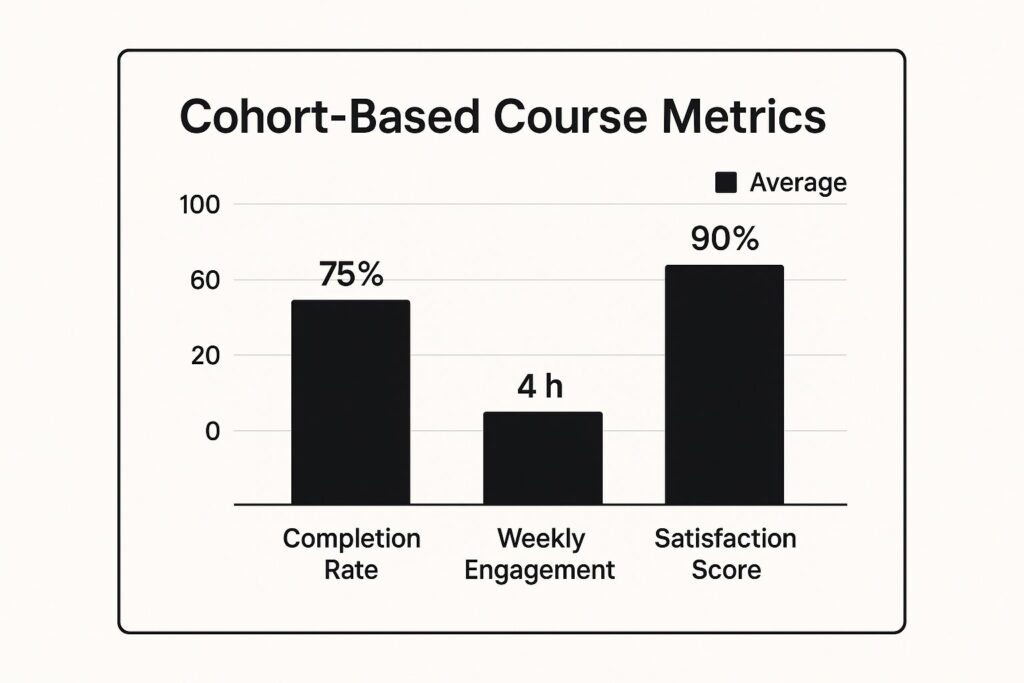
The combination of high completion, deep engagement, and genuine satisfaction makes this learning model uniquely powerful.
The Power of a Learning Community
Accountability gets you in the door, but community is what makes you want to stay. In a cohort course, you’re not just another face in the crowd. You’re part of a dedicated group of people who share your goals and are wrestling with the same challenges.
This peer support system is incredibly valuable. When you’re stuck on a concept, you can drop a question in the community channel and get a helpful answer from a classmate in minutes. This is a huge leap from waiting days for an email response.
Here’s how community truly transforms the learning experience:
- Diverse Perspectives: You learn almost as much from your peers as you do from the instructor. A classmate might explain a concept in a way that suddenly makes everything click.
- Building Connections: You’re not just learning a skill, you’re building a professional network. I’ve seen students from my own courses go on to collaborate on projects, refer each other for jobs, and become lifelong friends.
- Motivation Through Shared Progress: Seeing others in your cohort succeed and make progress is inspiring. It creates that powerful “if they can do it, so can I” feeling, which keeps everyone pushing forward together.
The real impact happens when students start teaching each other. That’s when you know you’ve built a true learning community, not just an online class.
This community aspect turns passive learning into an active, collaborative experience. You can even amplify this spirit by incorporating some friendly competition or fun challenges. We cover some of those ideas in our guide on using gamification for elearning.
Ultimately, a well-designed cohort course creates a powerful loop where everyone is invested in each other’s success. This makes the entire journey more effective and a whole lot more enjoyable.
How to Design Your First Cohort Course

Alright, you get why cohort-based courses are so powerful. Now for the fun part, and that’s building your own!
But let’s be clear, designing a great cohort course is more than just recording a few videos and crossing your fingers. It’s about intentionally crafting an experience that delivers real, tangible transformation.
I’m going to walk you through the essential pieces of designing a course that doesn’t just teach, but also inspires and connects your students. We’ll start at the very beginning, with the single most important question you need to answer.
Start with Clear Learning Outcomes
Before you even think about lesson plans, content, or community platforms, you have to answer this: What will my students be able to do after this course?
These are your learning outcomes, and they are everything. They need to be specific, measurable, and focused on action. Vague promises like “learn about marketing” are useless. You need to aim for concrete, provable skills.
- Weak Outcome: Understand social media marketing
- Strong Outcome: Create and launch a 30-day social media content calendar for Instagram
A strong outcome paints a crystal-clear picture for your students of the tangible skill they’ll walk away with. This clarity is for them, and it’s also your North Star for every single piece of content you create.
Structure a Curriculum That Builds Momentum
Once you have your outcomes dialed in, it’s time to build the curriculum. A classic mistake is to just dump a ton of information on students all at once. The real goal is to create a path that builds momentum, where each lesson flows logically into the next.
It’s similar to building a house. You pour the foundation before you put up the walls, and you put up the walls before you add the roof.
Your curriculum needs that same progressive structure, moving from foundational ideas to more advanced, hands-on application. To get started, check out our guide on how to create a free course outline template—it’s a huge help for mapping everything out.
A well-structured curriculum is the difference between a student feeling empowered and a student feeling completely overwhelmed. Each module should feel like a win, giving them the confidence to tackle the next one.
This structure is a huge reason why the cohort model works so well. In fact, some research shows that students in these programs are 3.6 times more likely to complete their courses than those in go-at-your-own-pace formats.
The model works like a team climbing a mountain together. Everyone moves forward as a group, celebrating milestones along the way.
Blend Your Content for Maximum Engagement
Nobody wants to sit through eight weeks of straight lectures, and that’s the challenge. To keep energy and engagement sky-high, you have to mix up your content formats.
A fantastic cohort-based course blends different types of learning to keep things interesting and cater to how different people learn best.
Here’s what a balanced mix can look like:
| Content Type | Purpose | Example |
|---|---|---|
| On-Demand Lessons | Deliver core concepts and foundational knowledge. | Short, pre-recorded videos (5-15 mins) that students can watch on their own schedule. |
| Live Workshops | Provide interactive learning and direct instructor access. | Weekly 60-90 minute Zoom calls for Q&A, live demos, or group discussions. |
| Hands-On Projects | Allow students to apply what they’ve learned. | A practical assignment where students build a small portfolio piece or solve a real-world problem. |
| Peer Feedback | Foster community and collaborative learning. | Students review each other’s project submissions in a dedicated community channel. |
This blend ensures students aren’t just passively consuming information. They’re actively applying it, discussing it, and getting feedback every step of the way. This active participation truly cements learning and makes the entire experience stick.
Building Community in Your Course
Think back to the best learning experiences you’ve ever had.
I’m willing to bet they didn’t happen in isolation. Maybe it was a late-night study group in college, a workshop where you collaborated on a project, or a conference where you connected with peers who just got it.
That sense of shared experience and mutual support is the magic ingredient that most self-paced online courses are missing. Cohort-based courses, on the other hand, are built around this very idea.
When students feel like they’re part of something bigger than themselves, like a team on a shared mission, everything changes. Motivation goes up, accountability becomes second nature, and the learning sticks.
According to a study by the Community Roundtable, 85% of members say that being part of a branded community has helped them learn or grow.
This isn’t about just adding a forum and hoping for the best. You need to intentionally design opportunities for connection and collaboration right into the fabric of your course.
The Power of Peer-to-Peer Learning
In a traditional course, the instructor is the “sage on the stage,” the single source of truth. In a cohort-based model, your role shifts to being the “guide on the side.” You’re still the expert, but you’re facilitating a learning environment where students teach and support each other.
This peer-to-peer dynamic is incredibly powerful for a few reasons. First, it scales your impact. You can’t be everywhere at once, but a supportive community can answer questions and provide feedback around the clock.
Second, teaching is one of the best ways to learn. When a student explains a concept to a peer, they’re forced to clarify their own understanding, which deepens their own mastery of the material.
Finally, it creates a much richer learning experience. Your students bring a diverse set of backgrounds, experiences, and perspectives to the table. Encouraging them to share those insights exposes everyone to ideas and solutions you might never have thought of on your own.
Building a Community Vibe
Fostering a genuine sense of community doesn’t happen by accident. It requires a deliberate strategy. Here are a few practical ways to get it done:
Kick things off with a bang: Start your course with a live welcome call or an icebreaker activity that gets everyone talking and sharing from day one. Ask fun, low-stakes questions to get the ball rolling.
Create smaller groups: Break your larger cohort into smaller “pods” or “mastermind groups” of 4-6 people. These smaller, more intimate groups make it easier for students to build real relationships and hold each other accountable.
Engineer collaborative projects: Don’t just teach concepts, give students a reason to apply them together. Group projects, peer review assignments, or case study discussions force students to engage with each other in a meaningful way.
Host regular live sessions: Weekly Q&As, “office hours,” or guest expert interviews give the cohort a reason to come together. These scheduled touchpoints create a rhythm for the course and make it feel like a shared, live experience.
For a deeper dive, our guide on how to build community in an online course is packed with more actionable strategies.
Benefits of Community
The goal is to create multiple touchpoints where students can connect, share their struggles, and celebrate their wins together. When you get this right, the community becomes just as valuable as the content itself, and sometimes even more so.
Watch how Tiago Forte, creator of the massively successful Building a Second Brain course, explains the importance of community in his model:
Your choice of technology can either make your cohort-based course an absolute joy for students or a clunky, frustrating mess. It’s a foundational decision.
With so many platforms and tools promising the world, picking the right one can feel paralyzing. I’m here to help you cut through that noise.
Let’s break down exactly what you should be looking for in your tech stack.
All-In-One Platforms vs. a Custom Tech Stack
The first big fork in the road is deciding whether to go with an all-in-one platform or piece together your own custom toolkit.
There are solid arguments for both, and the right answer really comes down to your specific course, your budget, and how much control you want.
An all-in-one platform tries to do everything under one roof. Think of it like a smartphone, it has the camera, GPS, and phone all built into one device. These platforms are designed to handle your live sessions, community discussions, content hosting, and payments in a single, integrated environment.
On the other hand, a custom tech stack is like building your own workshop. You pick the best-in-class tool for each specific job. You might use Zoom for live classes, Slack for community chat, and Teachable for hosting your course materials. This gives you incredible flexibility but also more moving parts to manage.
The platform you choose is more than just a place to host videos. It’s the digital campus for your course. It should feel seamless and inviting, not like a piece of clunky software that gets in the way of learning.
Platforms like Maven are a great example of an all-in-one solution built from the ground up specifically for cohort-based courses. It’s main use-case is instructor-led, interactive learning, which is the very heart of a great cohort experience.
The right platform makes this kind of engagement feel effortless, not like you’re fighting the software.
Core Features Your Tech Must Have
Regardless of which path you take, some features are simply non-negotiable. It’s easy to get distracted by fancy bells and whistles, but don’t even consider a tool until you’ve confirmed it can handle these core functions flawlessly.
Here’s a practical checklist of what you absolutely need:
Seamless Live Sessions: This is your virtual classroom, and it has to be rock-solid. Your platform needs either a great built-in live video tool or a perfect integration with something like Zoom. Make sure it supports essential features for active learning, like breakout rooms, Q&A functions, and a lively chat.
A Dedicated Community Hub: The magic of a CBC happens in the conversations between sessions. You need a clean, organized space where students can ask questions, share their work, and connect with each other. This is where your community actually takes root and grows.
Simple Content & Resource Management: Your students need an easy way to find and access course materials like pre-recorded videos, worksheets, and reading lists. If the interface is confusing, you’re just creating unnecessary friction and frustration.
Assignment and Feedback Tools: Students need a clear way to submit their work, and you need a straightforward system to provide feedback. Bonus points for peer-to-peer feedback features, which are a massive plus for building community and collaborative learning.
Hassle-Free Payment Processing: Getting paid should be the easy part. Make sure the platform integrates smoothly with payment gateways like Stripe or PayPal and can handle your pricing model, whether it’s a one-time fee, a payment plan, or a subscription.
Choosing your tech stack is a foundational step in creating successful cohort-based courses. It’s the infrastructure that supports the entire learning journey. Take your time, test out a few options, and always prioritize a smooth, frustration-free experience for your students.
Real-World Cohort Courses That Just Work
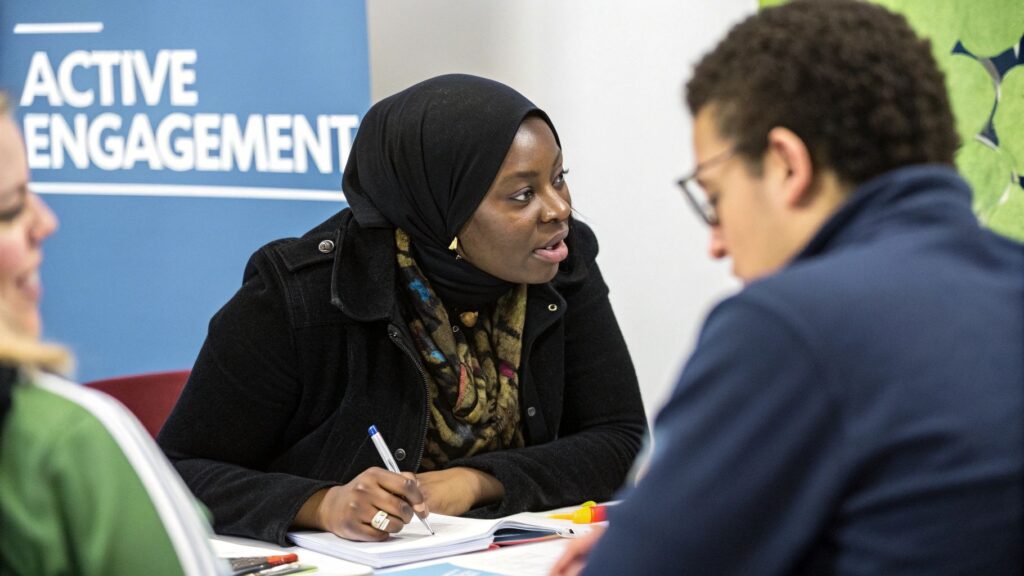
It’s one thing to talk about cohort courses in theory, but it’s another thing entirely to see them thriving out in the wild. Let’s move past the concepts and look at how some of the most successful creators are putting these ideas into practice.
Studying these examples isn’t just for a dose of inspiration. You can reverse-engineer what works. By looking at these courses, you can start to see what excellence looks like from both the student’s and the creator’s perspective.
A Masterclass in Niche Expertise
A perfect example of a successful cohort course is Tiago Forte’s Building a Second Brain. This course teaches a complete system for personal knowledge management.
It’s built on the promise of helping people organize their digital chaos and transform ideas into real, creative output.
So, what makes it so great?
- A Clear Transformation: The value proposition is incredibly powerful. It offers a specific, tangible solution to a pain point that nearly every knowledge worker feels, which is being completely overwhelmed by information.
- Premium Pricing for a Premium Experience: This course commands a high price tag, which signals the deep transformation it delivers. The cost is justified by the high-touch, community-first experience that students receive.
- Thriving Community: Students are joining a movement, not just learning a method. The course leverages a dedicated community space to foster real connections, share templates, and keep the energy going long after the live sessions have wrapped up.
Forte’s course is the perfect example in building a world-class educational brand around a single, powerful idea that resonates deeply with its audience.
The Power of Practical Application
Another fantastic example comes from Pat Flynn’s Smart Passive Income (SPI) community, which runs several cohort-based accelerators each year.
These are focused, action-oriented workshops on specific skills like podcasting or email marketing, rather than vague “build a business” courses.
Here’s why the SPI model is so effective:
The goal is to get students to take immediate action and see tangible results. The community structure provides the support and accountability needed to push through the inevitable hurdles of starting something new.
SPI’s accelerators are designed for doing, not just learning. They often end with students having launched a tangible project, which is the ultimate proof of learning.
This hands-on approach, combined with Flynn’s established reputation and a vibrant community, makes for a potent mix. It’s no wonder his courses boast completion rates 3x the industry average.
Why This Model Is Gaining Ground
These examples aren’t just one-offs. They’re part of a much larger shift where creators and companies alike are realizing the incredible value of learning together. The model is so powerful that even corporate training is moving in this direction.
A Brandon Hall Group survey really drives this point home. It found that 89% of organizations expected their use of cohort and collaborative learning to either increase or stay the same.
Even more telling, 69% rated it as highly or moderately effective, a figure that has more than doubled in just a few years. You can discover more about how organizations are realizing the potential of cohort-based learning in their full report.
This all points to one clear conclusion. Successful cohort based courses are far more than a passing trend.
Got Questions About Cohort Courses?
These are the same questions I heard when I was starting out. Let’s dive in.
How Much Should I Charge for My Course?
This is the big one, right? The honest answer is that it depends.
Pricing a cohort course is a mix of art and science, but one thing is certain. They are almost always priced higher than self-paced video courses. You’re offering direct access to you, a built-in community, and real accountability. That’s a premium experience, and it should be priced accordingly.
Most successful cohort-based courses land somewhere between $500 and $5,000, and some go even higher.
To find your sweet spot, you need to look at your niche, your expertise, the length of the course, and the real-world transformation you promise. A great starting point is to research what similar courses in your industry are charging to get a solid baseline.
What Is the Best Length for a Cohort Course?
Finding the right duration is a balancing act. You need enough time to cover your material in depth and let a real community form, but not so long that students start to lose steam.
The sweet spot for most cohort courses seems to be between 3 and 8 weeks. This timeline is long enough to deliver a ton of value but short enough to keep everyone focused and engaged from start to finish.
The most important thing is to match the length to the learning outcomes you’re promising. If you’re teaching a complex technical skill, you’ll probably need more time than if you’re teaching a “softer” skill like productivity or communication.
How Can I Keep Students Engaged Between Live Sessions?
The time between your live calls is where the magic really happens. If this space is dead silent, you lose momentum fast.
Here are a few simple but powerful ideas:
- Create a dedicated community space: A central hub on a platform like Slack or Circle is non-negotiable. Use it to post daily discussion prompts, share interesting articles, or ask fun, low-stakes questions to get the conversation flowing.
- Encourage peer feedback: Ask students to share small wins or drafts of their work. Then, actively encourage others to provide constructive feedback. This creates a powerful learning loop that doesn’t always have to involve you.
- Host optional ‘office hours’: These are unstructured, drop-in sessions where students can ask you questions directly. It’s a fantastic way to offer extra support without adding another formal, must-attend lesson to the calendar.
The key is to be intentional about sparking interaction and not just waiting for it to happen organically.
